
|
Vol. 45, Issue No. 140 |
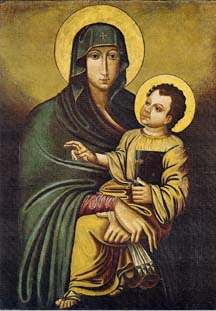
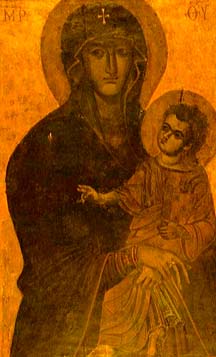 The Shrines of
The Shrines of
Mater Admirabilis
The Thrice Admirable Mother of Ingolstadt
The Catholic University of Ingolstadt was founded in 1472. One of its most illustrious professors of Theology was Dr. Johannes Eck, famous for his disputations against Martin Luther. Some time later a Jesuit College was instituted at the University, with the help of St. Peter Kanisius. In 1570, St. Francis Borgia, Superior General of the Jesuits, sent to the Jesuit College in Ingolstadt one of seven copies of the Image of Our Lady of the Snows (enshrined in the Basilica of St. Mary Major at Rome; also called "Salus Populi Romani" — Salvation of the Roman People), the painting of which had been permitted by Pope St. Pius V. These were not exact copies; rather the stark iconic look of the original had been somewhat softened.
Mary's image, thus enshrined in Ingolstadt, became a favorite place of prayer of a pious young Jesuit, Father Jakob Rem, who was stationed at nearby Dillingen. This religious, a fellow-novice of St. Stanislaus Kostka, was illustrious for his eminent virtues and, above all, for his devotion to Our Lady. He sought to instill in all his students a deep love for the Rosary — a love which was undoubtedly increased due to the well-known influence this devotion had in the victory at the Battle of Lepanto in 1571. While yet a novice in Rome, Father Rem had become acquainted with the Marian Congregation, a lay apostolate which had been founded by a Flemish Jesuit, Johann Leunis, in 1562.
As the Protestant revolution raged on, the staunchly Catholic Duke Albrecht encouraged everything which would help preserve Catholic faith and morals in Bavaria. Thus, when Father Rem established the first Marian Congregation on German soil, at Dillingen in 1574, his efforts were met with much enthusiasm. It was at the request of St. Peter Kanisius that Father Rem established a second Marian Congregation, in Ingolstadt in 1577. Its members would meet in the chapel where the copy of Our Lady of the Snows was enshrined.
After being transferred to Ingolstadt, Father Jakob Rem gathered the most elite and fervent members of the Marian Congregation. With them he formed, in 1595, the Colloquium Marianum (literally — Marian Conversation or Marian Conference); so-called because its members bound themselves always to try to say something in praise of Mary in their daily conversations, and because they would give and listen to conferences and have discussions about devotion to Mary in their meetings (as is done today at Fatima Cell meetings). The majority of the future spiritual and intellectual leaders of the Catholic "counter-reformation" were members of the Colloquium Marianum. Indeed, due to the efforts of Father Rem and the Colloquium Marianum, Ingolstadt became a center of Marian devotion, which was to have a profound influence, not only in Bavaria, but also throughout Europe.
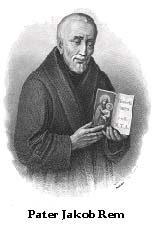 On April 6, 1604, Father Rem, together with the members of the Colloquium, were chanting the Litany of Loreto in Our Lady's chapel, as they were accustomed to do at their meetings. Father Rem had previously formed a great desire, out of pious curiosity, to know which of Our Lady's titles were most pleasing to her. On this day, as the chanting continued, Father Rem was lifted from the ground in ecstasy and beheld the Mother of God in a vision. She made known to him that the title "Mater Admirabilis" was especially pleasing to her, as it summed up all of her graces and privileges. Just as the vision ended, the cantor sang the invocation, "Mater Admirabilis", and all answered, "Ora pro nobis". Father Rem instructed the members to repeat the invocation two more times.
On April 6, 1604, Father Rem, together with the members of the Colloquium, were chanting the Litany of Loreto in Our Lady's chapel, as they were accustomed to do at their meetings. Father Rem had previously formed a great desire, out of pious curiosity, to know which of Our Lady's titles were most pleasing to her. On this day, as the chanting continued, Father Rem was lifted from the ground in ecstasy and beheld the Mother of God in a vision. She made known to him that the title "Mater Admirabilis" was especially pleasing to her, as it summed up all of her graces and privileges. Just as the vision ended, the cantor sang the invocation, "Mater Admirabilis", and all answered, "Ora pro nobis". Father Rem instructed the members to repeat the invocation two more times.
It was not long before the reason for this three-fold invocation became known, not only to the members of the Colloquium, but also to Father Rem's superiors. Soon it became the custom, at Ingolstadt and other places throughout Bavaria and Germany, to repeat this invocation three times whenever the Litany of Loreto was chanted. It was thus that the copy of Our Lady of the Snows at Ingolstadt became known as "Mater Ter Admirabilis" ("Thrice Admirable Mother" in English; "Dreimal Wunderbare Mutter" in German). The image of the Thrice Admirable Mother was later copied many times. Many missionaries took copies on their journeys and reported miraculous happenings through the intercession of the Thrice Admirable Mother.
The evil influence of the "Age of Enlightenment" was not combated with equal zeal. Interest in the Marian Congregation of Ingolstadt waned until eventually, in 1779, it was discontinued. But Mater Admirabilis was not to be outdone. By her intercession the work would be resumed, but in a different place and in a different way.
Mater Admirabilis in Rome
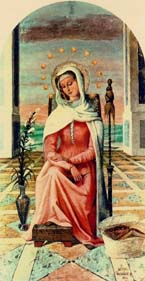 In the course of the month of May, 1844, when the excessive heat already weighed on the people of Rome, the Ladies of the Sacred Heart, in the Convent of Trinità dei Monti, according to their custom, left the common parlor, to occupy during their summer recreations, a large corridor, on the first story over a cloister adjoining the church of the Convent.
In the course of the month of May, 1844, when the excessive heat already weighed on the people of Rome, the Ladies of the Sacred Heart, in the Convent of Trinità dei Monti, according to their custom, left the common parlor, to occupy during their summer recreations, a large corridor, on the first story over a cloister adjoining the church of the Convent.
At the noon recreation, the Sisters of the community were entertaining themselves, conversing on this beautiful month consecrated to the Most Holy Virgin, and they were remarking with delight the pomp with which it is solemnized in Rome. Just then the Reverend Mother was called away. On seeing her place vacated, one of the Sisters exclaimed, "Ah! If the Holy Virgin would but deign to come and take the place of our Mother, and preside over our recreation!"
There was then in the common assembly a young postulant, who had come to Rome to finish some studies of painting. When she heard the religious invoke the presence of the Holy Virgin, her eyes fixed instantaneously upon an arched niche that was vacant, just in front of the Mother Superior's seat. To paint Mary in this niche, occupied in spinning, with a distaff near her on one side, and a lily on the other; to place by her feet the work-basket of the Superioress, and her footstool also; to represent on the upper part of the painting a fine view in perspective of the country around Rome — all this passed like lightning through the imagination of the postulant. Responding to the pious desire which had just been expressed, she said, "Would you like me to place the Most Holy Virgin in our Mother's seat?" "Yes, yes, bring our heavenly Mother in our midst," was the general response. "But how will you do it?" "That is my secret," answered the postulant. Here the project seemed to rest for a time. However, she who had broached the idea had not lost sight of it. The design of the painting was constantly in her mind; it impressed on her heart, in a still livelier manner, one of her dearest recollections — a devotion which, from her tenderest years, she had cultivated, for she had been taught to venerate the youthful Mary spinning within the precincts of the temple of Jerusalem. Often had the Holy Virgin been proposed to her as a model, particularly when, while still small, she also had to cover her spindle, as did this Most Holy Virgin.
But an insurmountable difficulty seemed to present itself to the execution of this design; the upper part of the niche could only be covered by fresco, a kind of painting above the talent of the postulant. A simple attempt to do it in fresco was all that was possible to her. She hesitated for a few days, then abandoned the idea. But Mary had decreed otherwise, for she gave her future painter so much remorse, that this young religious believed it more secure to submit her interior anguish to her Superioress. The latter, after having maturely weighed the subject, finally gave her permission, even ordering the novice to commence the fresco, thinking within herself that it would only be a failure; but, as she has since declared, she wished to give an occasion of humiliation to one who was soon to consecrate herself, by vow, to follow Jesus Christ, meek and humble of heart.
On the 1st of June, 1844, the work was undertaken. On the 22nd, the Feast of Our Lady of Peace, the pure head of the Madonna began to give animation to the painting, already far advanced, and, in the beginning of July, it was finished; but, alas! the desire of the Superioress was fully accomplished, for the trial to the novice was complete. The fresco, which was painted on fresh lime, held the colors so deeply, that instead of the flower of the field foretold and promised, one saw, with dismay, a gaudy figure, clothed in a poppy-colored robe, and a yellow-orange colored veil deployed around a dark and threatening brow!
Everyone in the house, and the artist herself, recoiled with horror from the sight of it, as all were ignorant of the strange effect of a fresco while still humid; they concealed its existence from the pupils and visitors.
The effacing became a serious question; until finally a fresco-worker, though not an experienced artist, having entered this corridor which had been transformed into a studio, repeated these words in an authoritative tone: "It is a very delicate flower, seen at the dawn of day, and still covered with dewdrops." The Sisters smiled at such language from the workman, but he entreated them to wait until the walls were dry. When they raised the drapery three weeks later, their joy was overwhelming — the colors were entirely transformed. The Children of Mary who were assembled, ornamented the blessed corridor, and chanted the first Magnificat, which resounded under those silent arches of the cloister, where the modest fresco was destined to receive so solemn a veneration. Being an object of tender devotion only to the religious and their pupils, the Madonna of the Lilies, as she was first called, remained in the shade for a short time.
The period of anonymity was ended by two events. The first was the blessing of the image by Pope Pius IX on October 20, 1846, only a few months after His election to the Chair of Peter. The Sovereign Pontiff was visiting the Convent of the Ladies of the Sacred Heart and was shown the fresco. "It was a pious thought," He remarked, "to represent the most holy Virgin at an age when she seems to have been forgotten." He was so pleased by the image, that He not only prayed before it, but solemnly blessed it then and there.
The second event took place only sixteen days later. Father Blampin, a missionary of the Congregation of the Sacred Heart of Mary, had completely lost his voice. No medical treatment was of any avail. As a last resort, he returned to Rome, hoping that the Italian air would help. By providence, he was led to the Convent of the Ladies of the Sacred Heart, and to the sanctuary of the Madonna. A holy religious advised Father Blampin to offer Mass in the chapel there every day for the recovery of his voice. Several days later, on November 6, he was also advised to try, after Mass, to recite three Aves every hour as loud as possible. He agreed to try, even though he was barely able to whisper the Mass, and had been forbidden by physicians to try to speak out loud. With his heart full of confidence, he recited the Aves without any difficulty. The community was immediately assembled by the ringing of the bell. Father Blampin recited the Litanies and the Te Deum himself, before Our Lady's image. Soon after, the young missionary was presented to Pope Pius IX. His Holiness listened to the account of the miracle with great interest, and permitted Father Blampin to celebrate a Mass of thanksgiving before the fresco itself. Thus it was that the corridor of the Madonna began to be transformed into a pilgrimage sanctuary. The first votive offering to be hung on the wall was a little slate — the one upon which Father Blampin wrote his reply to the religious who suggested the three Hail Marys. It was not long before the Madonna of the Lilies began to be called Mater Admirabilis — for the words admirable and miracle have the same root.
The devotion to Mater Admirabilis could not have been revived at a more propitious time. Pope Pius IX had been narrowly elected to the Papacy for the very reason that He was a political liberal. The Cardinals were hoping that His election would calm the storm of revolution that was brewing throughout Italy and Papal States. The new Pope imprudently hoped to win hearts and minds by releasing political prisoners. But many of them only used their freedom to provoke the revolt. Open rioting broke out in 1848 and, on November 24, Pius fled Rome in disguise, aided by the French and Bavarian ambassadors. The revolutionaries siezed the Holy City and committed untold atrocities. It was during this siege that the Ladies of the Sacred Heart promised to have a medal struck, honoring Mater Admirabilis, if the Sisters and students were spared from all harm. On July 2, the Feast of the Visitation, peace was restored to Rome by the arrival of French troops. Two weeks later, the first medals were struck. On December 12, a grateful Pope Pius IX established October 20 as the Feast of Mater Admirabilis and granted many indulgences to the new sanctuary.
Mater Admirabilis at Schönstatt and Marienfried
Pope Pius IX became a staunch enemy of liberalism of all kinds, but was unable to extinguish the flames of revolution that were spreading throughout Europe. Eventually He lost the Papal States and was reduced to being a virtual prisoner in the Vatican, as the new secular Italian government seized many Church properties. A similar thing was taking place in Germany — the so-called kulturkampf. The government of the newly formed "empire" of Kaiser Bismarck was an alliance of liberals and Protestants. Viciously anti-Catholic laws were passed, Church property seized, Religious houses closed, priests and bishops expelled and even imprisoned. Towards the close of the century, the persecution was dying down, but many faithful German Catholics were seeking ways to revitalize Catholicism in Germany.
In 1896, Father Franz Hattler SJ published The Venerable Father Jakob Rem of the Society of Jesus and his Colloquium Marianum, thus reviving the memory of the Thrice-Admirable Mother. An attempt was made soon after to revive the Colloquium Marianum in Feldkirch, Austria, but it met with little interest.
Schönstatt
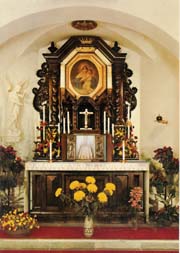 In 1912, Father Joseph Kentenich was made spiritual director of the College of Schönstatt — a high school seminary conducted by the Pallottine Fathers (founded by St. Vincent Pallotti). In 1914, a Marian Sodality was founded at the school, and Father Kentenich was surprised to see the enthusiasm which it enkindled. He felt that Divine Providence had special plans for the Sodality. The outbreak of World War I brought a sense of urgency to the work. Father Kentenich noticed more providential signs. The superior of the school offered the Sodality the old St. Michael's Chapel. Soon after, Father Kentenich read about Bartolo Longo, the layman who had established the Shrine of Our Lady of the Rosary of Pompeii. On October 18, 1914, during the first meeting of the Sodality in the old chapel, Father Kentenich announced his desire to establish a Marian Shrine there. He told the students that they must consecrate themselves to Mary and invite her to come and dwell in the little chapel.
In 1912, Father Joseph Kentenich was made spiritual director of the College of Schönstatt — a high school seminary conducted by the Pallottine Fathers (founded by St. Vincent Pallotti). In 1914, a Marian Sodality was founded at the school, and Father Kentenich was surprised to see the enthusiasm which it enkindled. He felt that Divine Providence had special plans for the Sodality. The outbreak of World War I brought a sense of urgency to the work. Father Kentenich noticed more providential signs. The superior of the school offered the Sodality the old St. Michael's Chapel. Soon after, Father Kentenich read about Bartolo Longo, the layman who had established the Shrine of Our Lady of the Rosary of Pompeii. On October 18, 1914, during the first meeting of the Sodality in the old chapel, Father Kentenich announced his desire to establish a Marian Shrine there. He told the students that they must consecrate themselves to Mary and invite her to come and dwell in the little chapel.
In April of the following year, a teacher donated a beautiful image of Mary for the proposed shrine. It was a print from a painting by Luigi Crosio, made in 1898, and originally titled Refuge of Sinners. Within two months of the picture being enshrined, Father Kentenich read Father Hattler's book about the Colloquium Marianum and shared its contents with the Sodalists. Immediately it was decided to rename the picture Thrice Admirable Mother, although the image was only slightly reminiscent of the Madonna of Ingolstadt. The members of the Sodality began speaking of the "Ingolstadt-Schönstatt Parallel" and their hope that their Sodality could produce the same fruit as the original Colloquium Marianum. Toward the end of the year, Father Kentenich presented the Sodalists with the spiritual doctrine of St. Louis Marie de Montfort and his book True Devotion to Mary. Total Consecration to Mary would be the goal of the movement.
In 1916, inspired by the doctrine of St. Vincent Pallotti, Father Kentenich decided that the "Schönstatt Movement" should be international. Using the new image of Mater Ter Admirabilis, the movement would encourage Catholics not only to increase their devotion to Mary, but also to consecrate themselves to her. Wayside shrines with the new image soon sprang up all over Germany. Copies of the image were enshrined in churches, chapels, and private homes throughout Europe. A full replica of the Shrine of Schönstatt was established in Uruguay in 1943. Many others soon followed, notably in Chile, Argentina, Brazil, and Paraguay.
Marienfried
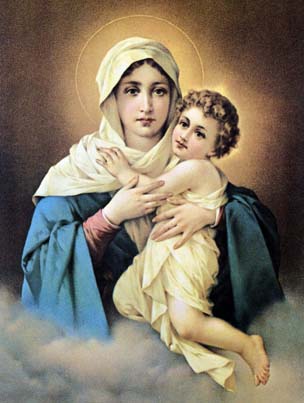
On May 25, Bärbel and Anna went again to Marienfried in order to ornament the little shrine with fresh flowers. The two lingered there to pray, when the Lady appeared again to Bärbel. This time she called herself "the great Mediatrix of Graces." She gave a lengthy message to Bärbel and said she would return on June 25.
During the final apparition, the Lady acknowledged that many (but a relatively small group) had honored her with the title, Mater Admirabilis. She lamented, however, that although she had already given so many signs and spoken to the world so often, most men had not taken them seriously. She added that she would work her wonders in secret, in the souls of her children. Men should not expect further signs and wonders. Bärbel asked the Lady (whom she was convinced was the Blessed Virgin Mary), if she wanted the promised chapel to be built there. The Lady said, "I have fulfilled your request; keep your promise here." Then Bärbel asked what image should be used in the chapel. The Lady pointed to the picture of the Thrice Admirable Mother and told Bärbel that they should use that image, for already many people had offered prayers and sacrifices before that image, and she willed that many more would come and do the same.
The history of Mater Admirabilis teaches us that Our Lady always comes to the aid of her children in times of great need, by inspiring them to a greater devotion and confidence in her intercession. Although in these darkest of times, most who claim to honor her are themselves infected with heresy and liberalism, Mater Admirabilis continues to work her wonders in secret, in the souls of her true children.
More on the Message of Marienfried
Visit also: www.marienfried.com
